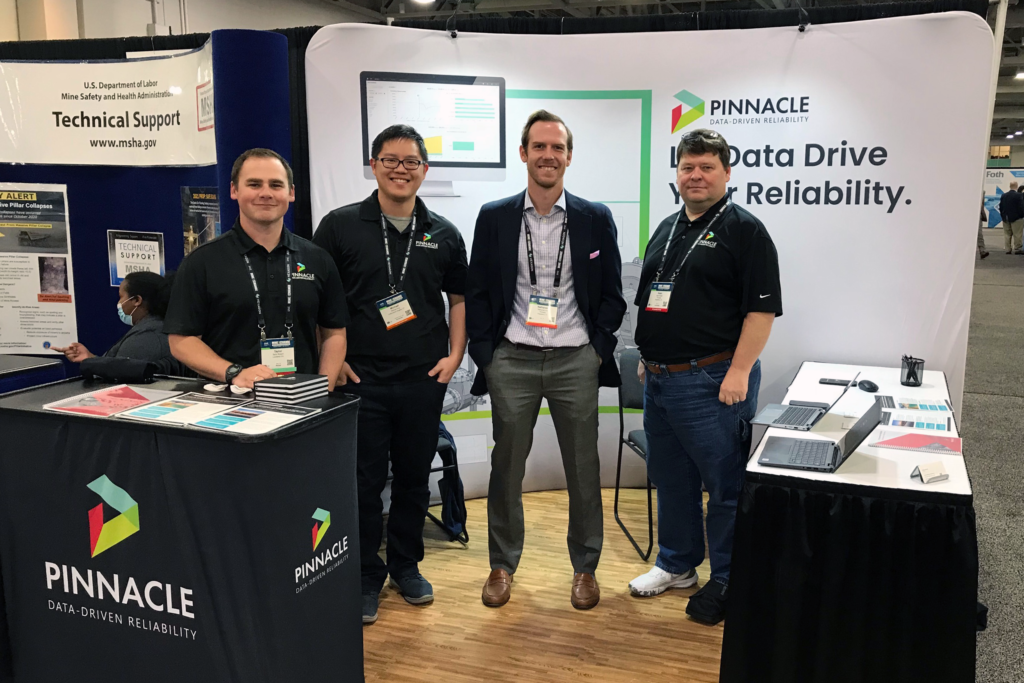Leveraging Data Effectively in the Mining Industry: Recap of 2022 MINExchange
Salt Lake City, Utah – February 27 – March 2
Do your reliability initiatives actually impact the performance of your mine? Without the proper tools and data in place, it can be difficult to predict the impact of your decisions on the profitability and long-term success of your mine.
We recently attended the 2022 MINExchange Society for Mining, Metallurgy, & Exploration (SME) Annual Conference & Expo in Salt Lake City, Utah. We saw two main themes during our time on the expo floor.

With Ample New Technologies in the Industry, Mines Need to Utilize Technologies Based on Specific Value Provided to Mine
The mining industry is being flooded with new data monitoring and modeling technologies. There has been a recent emergence of various data collection tools and software including process data monitoring, mobile fleet monitoring, slope monitoring, robotic scanning, and process asset condition monitoring for vibration and ultrasonics. While these technologies exemplify the significant advancements of hardware and software in the mining industry, many of these technologies focus on solving a point solution. The value of these technologies can be difficult to scale across the organization and can result in siloed operations.
To recognize the most value of these new technologies, decision makers should focus on the value case that fits into their mine’s holistic technology solution vision. Value cases include process optimization, maintenance optimization, human safety, and mine life extension. Contextualizing how this new technology fits into a mine’s holistic technology solution vision will help decision makers better understand how a specific new technology will bring value to their data collection, modeling, and decision-making processes.
Operations in the Mining Industry Are Heavily Siloed
The second theme we saw during the conference was how siloed operations in the mining industry. For example, most technologies and technical teams are focused on particular segments of the mine ranging from mine and processing to inventory and transportation. Often, when decision makers are needing to drive the value case of a new technology across their entire mine operation, they face the large-scale challenge of promoting collaboration between teams to ensure their mine’s overarching goals are met. Additionally, the siloed nature of mines can make it difficult to ensure that different technologies are being leveraged together and utilized after their first use case.
The Path Forward: Data-Driven Reliability
Miners must be able to recognize the value of new technology to justify their reliability spending and protect their long-term profitability. We studied the financial reports of 15 publicly traded metal miners in our Economics of Reliability – Global Metal and Fertilizer Mining report and found that the mining industry spends about $55 billion on reliability initiatives. Additionally, we saw that the portfolio of miners we analyzed spent 4% to 10% of revenue on reliability. However, in our experience, we have seen that 10% to 30% of this spend may not actually impact performance.
As a response to turbulent market pressures, fluctuating commodity prices, and the COVID-19 pandemic, many miners have drastically cut expenditures across the board to protect their profitability. While these moves may have temporarily alleviated pressure to protect profitability, these delayed expenditures will most likely create larger issues in the future. The key to protecting long-term profitability and performance is having the ability to strategically target reliability spending instead of drastically cutting expenses across the board.
The two themes we observed during the MINExchange conference show the industry’s need for an approach to reliability that breaks down the siloes in operations and integrates data models through value-driven technology selection and implementation. With Data-Driven Reliability, miners have a large opportunity to improve total production, optimize their maintenance spending, and mitigate process safety and environmental risk with greater confidence to make better decisions across their mine.
Stay in the know.
Providing data-driven insights, perspectives, and industrial inspiration from the forefront of the reliability transformation.